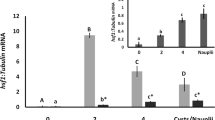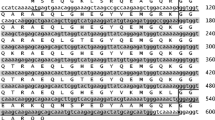Abstract
Diapause-destined embryos of the crustacean, Artemia franciscana, accumulate large amounts of an oligomeric, heat-stable, molecular chaperone termed artemin, a cysteine-enriched ferritin homologue. In this study, cysteines 22, 61, 166, and 172 of artemin were substituted with alanines, respectively yielding ArtC22A, ArtC61A, ArtC166A, and ArtC172A. Wild-type and modified artemins were synthesized in transformed bacteria and purified. As measured by heat-induced denaturation of citrate synthase in vitro, each substitution reduced chaperone activity, with ArtC172A the least active. Protein modeling indicated that C172 is close to a region of surface hydrophobicity, also present in ferritin, suggesting that this site contributes to chaperone activity. Only slight differences in oligomer molecular mass were apparent between artemin variants, but ArtC22A and ArtC61A displayed significantly reduced thermostability, perhaps due to the disruption of an inter-subunit disulphide bridge. In contrast, ArtC172A was thermostable, reflecting the location of C172 on the oligomer surface and that it contributes minimally to artemin stabilization. To our knowledge, this is the initial study of structure/function relationships within a ferritin homologue of importance in diapause and the first to indicate that a defined region of hydrophobicity contributes to artemin and ferritin chaperoning.







Similar content being viewed by others
References
Baraibar MA, Barbeito AG, Muhoberac BB, Vidal R (2008) Iron-mediated aggregation and a localized structural change characterize ferritin from a mutant light chain polypeptide that causes neurodegeneration. J Biol Chem 283:31679–31689
Chen T, Amons R, Clegg JS, Warner AH, MacRae TH (2003) Molecular characterization of artemin and ferritin from Artemia franciscana. Eur J Biochem 270:137–145
Chen T, Villeneuve TS, Garant KA, Amons R, MacRae TH (2007) Functional characterization of artemin, a ferritin homolog synthesized in Artemia embryos during encystment and diapause. FEBS J 274:1093–1011
Clegg JS (1994) Unusual response of Artemia franciscana embryos to prolonged anoxia. J Exp Zool 270:332–334
Clegg JS (1997) Embryos of Artemia franciscana survive four years of continuous anoxia: the case for complete metabolic rate depression. J Exp Biol 200:467–475
Clegg JS, Jackson SA (1998) The metabolic status of quiescent and diapause embryos of Artemia franciscana (Kellogg). Arch Hydrobiol Spec Issues Adv Limnol 52:425–439
Clegg JS, Willsie JK, Jackson SA (1999) Adaptive significance of a small heat shock/α-crystallin protein (p26) in encysted embryos of the brine shrimp, Artemia franciscana. Am Zool 39:836–847
Clegg JS, Jackson SA, Popov VI (2000) Long-term anoxia in encysted embryos of the crustacean, Artemia franciscana: viability, ultrastructure, and stress proteins. Cell Tiss Res 301:433–446
De Graaf J, Amons R, MÖller W (1990) The primary structure of artemin from Artemia cysts. Eur J Biochem 193:737–750
Drinkwater LE, Clegg JS (1991) Experimental biology of cyst diapause. In: Browne RA, Sorgeloos P, Trotman CNA (eds) Artemia biology. CRC, Boca Raton, pp 93–117
Drinkwater LE, Crowe JH (1987) Regulation of embryonic diapause in Artemia: environmental and physiological signals. J Exp Zool 241:297–307
Fan R, Boyle AL, Cheong VV, Ng SL, Orner BP (2009) A helix swapping study of two protein cages. Biochemistry 48:5623–5630
Harrison PM, Arosio P (1996) The ferritins: molecular properties, iron storage function and cellular regulation. Biochim Biophys Acta 1275:161–203
Humphrey W, Dalke A, Schulten K (1996) VMD—visual molecular dynamics. J Mol Graph 14:33–38
Jackson SA, Clegg JS (1996) Ontology of low molecular weight stress protein p26 during early development of the brine shrimp, Artemia franciscana. Dev Growth Differ 38:153–160
Kilic MA, Spiro S, Moore GR (2003) Stability of a 24-meric homopolymer: comparative studies of assembly-defective mutants of Rhodobacter capsulatus bacterioferritin and the native protein. Prot Sci 12:1663–1674
Kumsta C, Jakob U (2009) Redox-regulated chaperones. Biochemistry 48:4666–4676
Liang P, MacRae TH (1999) The synthesis of a small heat shock/α-crystallin protein in Artemia and its relationship to stress tolerance during development. Dev Biol 207:445–456
MacRae TH (2003) Molecular chaperones, stress resistance and development in Artemia franciscana. Semin Cell Dev Biol 14:251–258
MacRae TH (2005) Diapause: diverse states of developmental and metabolic arrest. J Biol Res 3:3–14
MacRae TH (2010) Gene expression, metabolic regulation and stress tolerance during diapause. Cell Mol Life Sci 67:2405–2424
Merritt EA, Bacon DJ (1997) Raster3D photorealistic molecular graphics. Meth Enzymol 277:505–524
Park SK, Jung YJ, Lee JR, Lee YM, Jang HH, Lee SS, Park JH, Kim SY, Moon JC, Lee SY, Chae HB, Shin MR, Jung JH, Kim MG, Kim WY, Yun D-J, Lee KO, Lee SY (2009) Heat-shock and redox-dependent functional switching of an h-type Arabidopsis thioredoxin from a disulfide reductase to a molecular chaperone. Plant Physiol 150:552–561
Qiu Z, MacRae TH (2008a) ArHsp21, a developmentally regulated small heat-shock protein synthesized in diapausing embryos of Artemia franciscana. Biochem J 411:605–611
Qiu Z, MacRae TH (2008b) ArHsp22, a developmentally regulated small heat shock protein produced in diapause-destined Artemia embryos, is stress inducible in adults. FEBS J 275:3556–3566
Qui Z, Tsoi SCM, MacRae TH (2007) Gene expression in diapause-destined embryos of the crustacean, Artemia franciscana. Mech Dev 124:856–867
Rasti B, Shahangian SS, Sajedi RH, Taghdir M, Hasannia S, Ranjbar B (2009) Sequence and structural analysis of artemin based on ferritin: a comparative study. Biochim Biophys Acta 1794:1407–1413
Reynolds C, Damerell D, Jones S (2009) ProtorP: a protein–protein interaction analysis server. Bioinformatics 25:413–414
Robbins HM, Van Stappen G, Sorgeloos P, Sung YY, MacRae TH, Bossier P (2010) Diapause termination and development of encysted Artemia embryos: roles for nitric oxide and hydrogen peroxide. J Exp Biol 213:1464–1470
Šali A, Blundell TL (1993) Comparative protein modeling by satisfaction of spatial restraints. J Mol Biol 234:779–815
Sun Y, MacRae TH (2005) Small heat shock proteins: molecular structure and chaperone function. Cell Mol Life Sci 62:2460–2476
Tanguay JA, Reyes RC, Clegg JS (2004) Habitat diversity and adaptation to environmental stress in encysted embryos of the crustacean Artemia. J Biosci 29:489–501
Theil EC, Matzapetakis M (2006) Ferritins: iron/oxygen biominerals in protein nanocages. J Biol Inorg Chem 11:803–810
Thompson JD, Higgins DG, Gibson TJ (1994) CLUSTAL W: improving the sensitivity of progressive multiple sequence alignment through sequence weighting, position-specific gap penalties and weight matrix choice. Nucl Acids Res 22:4673–4680
Van Breukelen F, Maier R, Hand SC (2000) Depression of nuclear transcription and extension of mRNA half-life under anoxia in Artemia franciscana embryos. J Exp Biol 203:1123–1130
Van Der Linden A, Blust R, Van Laere AJ, DeCleir W (1988) Light-induced release of Artemia dried embryos from diapause: analysis of metabolic status. J Exp Zool 247:131–138
Viner RI, Clegg JS (2001) Influence of trehalose on the molecular chaperone activity of p26, a small heat shock/α-crystallin protein. Cell Stress Chaperones 6:126–135
Warner AH, Brunet RT, MacRae TH, Clegg JS (2004) Artemin is an RNA-binding protein with high thermal stability and potential RNA chaperone activity. Arch Biochem Biophys 424:189–200
Acknowledgments
This work was supported by a Natural Sciences and Engineering Research Council of Canada Discovery Grant to THM. Dr. Tao Chen generated mutations ArtC22A and ArtC61A.
Author information
Authors and Affiliations
Corresponding author
Additional information
Yan Hu and Svetla Bojikova-Fournier contributed equally to the paper.
Rights and permissions
About this article
Cite this article
Hu, Y., Bojikova-Fournier, S., King, A.M. et al. The structural stability and chaperone activity of artemin, a ferritin homologue from diapause-destined Artemia embryos, depend on different cysteine residues. Cell Stress and Chaperones 16, 133–141 (2011). https://doi.org/10.1007/s12192-010-0225-7
Received:
Revised:
Accepted:
Published:
Issue Date:
DOI: https://doi.org/10.1007/s12192-010-0225-7




